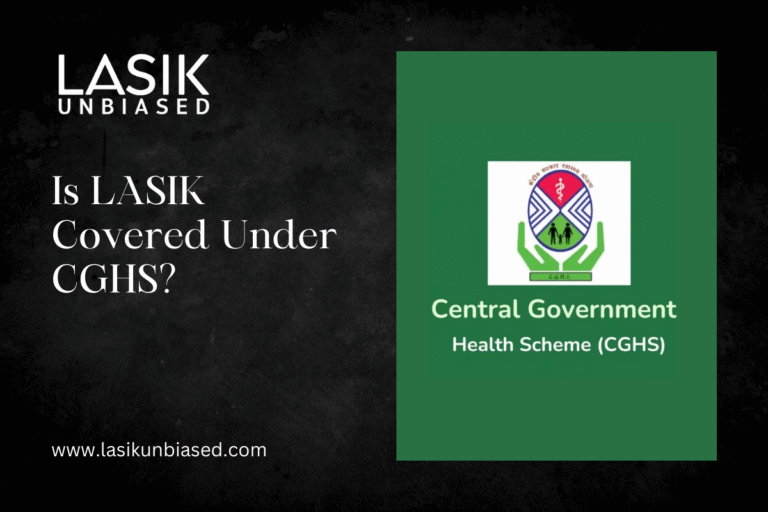No, LASIK surgery is not covered under the Central Government Health Scheme (CGHS).
It is classified as an elective or cosmetic procedure; hence, it is not eligible for medical reimbursement.
For Central Government Health Scheme (CGHS) beneficiaries, comprehending what procedures are covered under the scheme is vital. While CGHS offers a comprehensive list of surgeries and treatments, LASIK, a popular laser vision correction surgery, has not been included. This concise guide will walk you through why LASIK remains excluded and what implications this has for those seeking vision correction surgery under CGHS.
Understanding LASIK Surgery
LASIK (Laser-Assisted in Situ Keratomileusis) is a popular surgical method used to treat refractive issues like nearsightedness (myopia), farsightedness (hyperopia), and astigmatism. The aim is to reduce or eliminate the dependence on prescription glasses or contact lenses.
The process involves reshaping the cornea using a laser, enabling light to focus correctly on the retina, thereby improving vision. Although widely regarded as safe and effective, LASIK surgery is considered elective and categorised under cosmetic treatments rather than medical necessities by several health schemes, including CGHS.
Why is LASIK Considered a Cosmetic Surgery?
LASIK surgery is perceived as a “lifestyle-enhancing” procedure rather than a health-critical one. Its objective is to enhance visual convenience but not to address severe eye diseases or sight-threatening conditions.
For CGHS and similar health schemes, determining whether a treatment is medical or cosmetic often hinges on whether it has a direct impact on the patient’s health or ability to function. Since LASIK primarily aims to reduce dependency on eyewear and does not treat any life-threatening or debilitating condition, it is excluded from coverage.
How Treatments Are Evaluated Under CGHS?
The CGHS provides robust health coverage to central government employees and retirees. It includes a vast selection of surgeries, hospital treatments, and medications. However, strict guidelines are in place to determine which treatments are reimbursable.
- Necessary Medical Treatments – Covered services generally include those required to manage or cure illnesses that significantly affect an individual’s functional capacity or well-being. Examples include cataract surgery, glaucoma treatment, or retinal detachment procedures.
- Elective or Cosmetic Treatments – Procedures deemed non-essential for physical health typically fall outside the scope of CGHS. LASIK falls under this category due to its elective nature.
LASIK surgery, as a result, does not meet the CGHS reimbursement criteria for necessary medical procedures.
Can LASIK Ever Be Considered for Exceptional Coverage?
While standard CGHS regulations clearly exclude LASIK, certain conditions or severe complications might lead to rare exceptions. Although LASIK is fundamentally elective, there may be cases where a compelling medical justification alters eligibility under other schemes (not CGHS):
- Accidental or Trauma Cases – If significant vision impairment arises due to accidents or trauma and LASIK surgery appears to resolve it, other healthcare policies may cover it.
- Disease-Related Vision Issues – Medical conditions leading to extreme visual impairments that can’t be corrected with glasses might have provisions under different schemes.
However, these situations remain outliers and are typically subject to strict scrutiny.
Are Alternatives Like Cataract Surgery Covered Under CGHS?
Yes, cataract surgery, unlike LASIK, is medically covered under CGHS. This is because cataract conditions are considered health-compromising and directly impact an individual’s essential functions, unlike LASIK’s elective nature.
For beneficiaries with concerns about eye conditions unrelated to corrective surgery, this distinction between necessary surgeries like cataracts and cosmetic options like LASIK is critical. Beneficiaries should refer to the official CGHS treatment list to determine which eye-related interventions qualify under the scheme.
Costs Associated with LASIK Surgery
Individuals considering LASIK surgery outside CGHS must budget for the expenses themselves, as no reimbursement options exist under the scheme.
Prices can vary depending on the procedure’s complexity and location:
- Standard LASIK Surgery can cost anywhere between ₹30,000 to ₹60,000 for both eyes.
- Advanced LASIK Procedures (such as blade-free or contoura vision surgery) may reach ₹80,000 to ₹1,50,000.
While these expenses can be steep, patients often report satisfaction with the convenience and outcomes of improved vision post-surgery.
What Are Your Options If LASIK Is Not Covered?
If you’re a CGHS beneficiary considering LASIK, here are alternative routes to finance this procedure:
Check Employer Mediclaim Benefits
Many private employers and some public-sector units offer separate Mediclaim or health insurance policies that may partially cover LASIK. It’s worth checking with your workplace to confirm the inclusions of your health coverage.
Explore Health Insurance Plans
Not all health insurers exclude LASIK. Some advanced health insurance plans offer significant flexibility. You may find plans dedicated to covering conditions that CGHS does not address.
Always read the fine print and understand the inclusions explicitly.
Use No-Cost EMI Plans
Several eye clinics and hospitals offer financing for LASIK via no-cost EMI schemes. These plans allow you to pay for the procedure in affordable monthly instalments rather than bearing an upfront financial burden.
Consider Tax Benefits
As per Section 80D of the Income Tax Act, individuals are eligible to claim deductions for premiums paid towards health insurance policies. If you secure additional coverage explicitly for LASIK, it might assist in reducing your taxable income.
Final Takeaway
For government employees and CGHS beneficiaries, it is crucial to note that LASIK surgery will not be reimbursed under CGHS policies. This is because LASIK is classified as a cosmetic, elective surgery for improving vision rather than a necessary medical intervention.
Individuals keen on LASIK should explore other financing options, including customised health insurance policies or self-funded payment plans. Additionally, beneficiaries are advised to consult the official CGHS guidelines regularly to stay updated with any changes in covered treatments.
If you’re seeking better clarity or guidance on managing the expenses of LASIK, consult your eye-care professional or a financial advisor to discuss your options.


